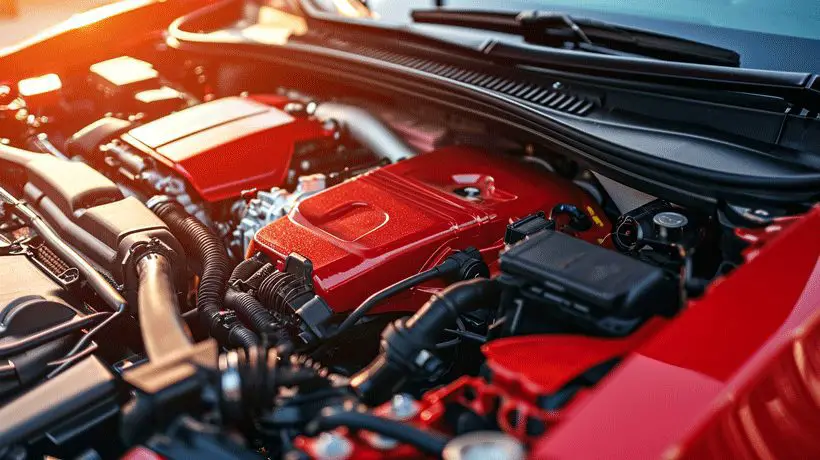Discovering a mysterious puddle under your car can be unsettling. I’ve been there, staring at that spot on the driveway, wondering what it means for my car’s health and my wallet. It’s crucial to identify what type of fluid is leaking; it could be anything from a harmless air conditioning drip to a critical brake fluid leak.
Knowing how to pinpoint the source and type of leak is the first step in tackling the problem. I’ll guide you through the common types of automotive fluids, so you can quickly figure out what your car is trying to tell you. Let’s decode those drips and get you back on the road with confidence.
Common Types of Automotive Leaks
If I notice a puddle under my car, it’s time to play detective. The color and location of the leak often provide vital clues about what’s going on. Here’s a primer on the common types of automotive leaks to help narrow down the possibilities.

Engine Oil
One of the most common leaks stems from engine oil, which can range from a light brown to black in color. It’s typically found under the engine area of the car. If I spot this type of leak, it might be due to a worn seal or gasket. Persistent oil leaks require immediate attention, as oil is critical for lubricating and protecting the engine’s internal components.
Coolant
Another frequent visitor on driveways and garage floors is coolant, also known as antifreeze. This fluid has a distinct sweet smell and appears bright green, orange, pink, or blue. It’s usually noticeable near the front of the car, where the radiator and hoses are located. Should my car start leaving these colorful clues, it could indicate a failing radiator, hose, or water pump.
Transmission Fluid
Transmission fluid leaks are less common but no less serious. This fluid is often reddish and found near the middle or front of the vehicle, where the transmission sits. Detecting a leak here could mean trouble for the transmission system, which may result in a need for an urgent visit to a mechanic.
Brake Fluid
Slightly less viscous than engine oil, brake fluid is a light, yellowish to brownish liquid. If I notice a leak under the brake pedal area or near the wheels, it might be the brake system warning me of a potential safety issue.
Power Steering Fluid
Leaking power steering fluid can appear similar to transmission fluid but may be found near the front of the car close to the steering gear. It could denote a leaky hose or a problem with the steering pump.
Identifying these leaks quickly is the key to ensuring small problems don’t turn into major repairs. Regular inspection and timely maintenance prevent leaks from becoming automotive emergencies, keeping me‚Äîand my wallet‚Äîin the driver’s seat when it comes to car care.
How to Identify a Leaking Fluid

When I notice a puddle beneath my car, I know it’s critical to figure out which fluid is leaking. To properly identify the culprit, I analyze its color, location, and consistency. This process ensures I’m well-informed before I head to the mechanic.
Engine oil leaks are easy to spot due to their dark brown or black color. They’re usually thick and can leave a slippery residue on my fingertips. I’ll find these under the engine or on the ground directly below where the engine sits. Checking the oil level with the dipstick is a quick way to confirm a leak if I suspect that’s the issue.
For a coolant leak, I’ll look for a vibrant green, orange, pink, or blue fluid towards the front of my vehicle. The sweetness of the smell is a telltale sign. A low coolant level in the reservoir or a warning light on my dashboard often accompanies this type of leak.
Transmission fluid has a distinctive reddish hue that’s easier to detect in the light. I’ll find it near the center of the vehicle’s underside, aligned with the transmission. My car might also exhibit signs of transmission issues, such as trouble shifting gears or a delayed response from the transmission.
Brake fluid is vital for my safety, so a leak is cause for immediate attention. Its yellowish to brown color and slick texture set it apart, typically seen under the brake pedal area or by the wheels. If my brake pedal feels spongy or I need to press it further than usual, I should check for a brake fluid leak right away.
Lastly, power steering fluid can look similar to transmission fluid but is usually found near the steering gear. Difficulty steering or a whining noise when I turn the wheel can be indicators that I’ve got a power steering fluid issue on my hands.
Each fluid in my car has a distinct role, so understanding these nuances prevents me from getting stranded or facing a hefty repair bill. Regular checks for these telltale signs will keep my car running smoothly.
Oil Leaks
When I notice a dark spot forming under my vehicle, it’s time to consider the possibility of an oil leak. These leaks can be identified by their dark brown or black color, and they’re typically found under the engine where it’s most susceptible to wear and tear. Oil’s consistency is slick, making it distinguishable from other automotive fluids.
Identifying the exact source of an oil leak is crucial. Common culprits often include worn gaskets, oil pan damage, or deteriorating seals. The engine oil is vital for lubricating engine parts, and without it, the engine is prone to overheating and severe damage.

One unmistakable sign of an engine oil leak is the burnt oil smell that comes when the leaking oil drips onto hot engine parts. Occasionally, you might also notice smoke emerging from the engine area, which can be alarming. It’s imperative to address these symptoms promptly to maintain engine health.
My practical experience has shown me that the area around the oil filter and oil plug should be checked regularly for potential leaks. Consistent maintenance, like tightening bolts and replacing worn parts, can effectively mitigate these issues. Spotting these leaks early on can save a significant amount of time and money in the long run.
Understanding the severity of leaks is essential. A few drops here and there might not signal an immediate crisis, but a steady drip indicates a more urgent issue. Monitoring your car’s oil level and condition should be a regular part of your maintenance routine to avoid unexpected breakdowns.
It’s worth noting that older vehicles may exhibit more frequent oil leak issues due to the natural aging of their components. Upkeep and regular checks become increasingly important as a car ages. For newer models, however, spotting an oil leak early can help maintain your vehicle’s warranty and its resale value, making those routine inspections all the more valuable.
Coolant Leaks
As I delve deeper into automotive fluid identification, it’s crucial to recognize the signs of coolant leaks. These leaks typically manifest as a bright green, orange, pink, or blue fluid beneath the center or front of your car. Occasionally, the color may vary depending on the type of coolant your vehicle uses. Coolant, also known as antifreeze, plays a pivotal role in regulating your engine’s temperature, and spotting a coolant leak promptly is key to preventing overheating.

When I inspect for coolant leaks, I’m not just looking for the vivid hue. This type of leak often has a sweet, syrup-like smell, which can be a tell-tale sign. It’s slick to the touch, much like engine oil, but the distinct odor sets it apart. If you notice your vehicle’s temperature gauge climbing or see steam coming from under the hood, it could be an indicator that coolant is leaking and the engine is running hot.
The usual suspects for coolant leaks include:
- Worn out hoses
- Faulty radiator cap
- Damaged water pump
- Corroded radiator
I prefer to check these components regularly, as wear and tear over time are common culprits. It’s equally important to monitor the coolant reservoir and radiator for any signs of leak or damage. Should I discover a drop in the coolant level without an obvious leak, it could suggest a more complex issue, such as a potential head gasket failure or an internal leak.
Routine checks form a vital part of my car maintenance schedule. Not only do they keep the vehicle performing optimally, but they also give me peace of mind on the road. Regularly consulting my mechanic for inspections and using quality coolant products can help to extend the life of the car’s cooling system significantly.
Vehicle maintenance might seem daunting at first, but understanding coolant leaks has definitely made me more confident in handling car care. Keeping an eye on these details has saved me from costly repairs and ensured that my drives remain safe and uninterrupted.
Transmission Fluid Leaks
When I’m inspecting my car for leaks, one fluid I pay particular attention to is the transmission fluid. Transmission fluid leaks are typically reddish or brownish and have a slick consistency. Unlike motor oil, transmission fluid has a distinctively sweet or tart scent. Spotting a patch of this under your car could suggest a potential issue with the transmission system, and it’s vital to address it promptly.
Locating a transmission fluid leak is often straightforward. You’ll most likely find the signs of a leak near the front of the vehicle, where the transmission itself is housed. If you see fluid pooling directly beneath the center or slightly off-center of the engine, it’s a strong indication. The usual suspects for this type of leak include a faulty transmission pan gasket, broken seals, or damaged fluid lines.
To get a better understanding of where the leak might be coming from, I start by checking the transmission dipstick. A low fluid level often corroborates your suspicion of a leak. Here’s what you need to remember about transmission fluid levels:
- Never overlook a low fluid level; it can lead to shifting problems and transmission overheating.
- If the fluid appears dirty or has a burnt smell when checking the dipstick, this could indicate a deeper issue.
I also take note of the texture and color of the fluid:
| Fluid Characteristic | Indicator |
|---|---|
| Bright Red | Fresh Transmission Fluid |
| Dark Brown/Black | Old or Burnt Fluid |
Should you suspect a transmission fluid leak, it’s advisable to check the condition of the cooler lines as well as the transmission fluid pan for any signs of damage. Tightening up bolts and replacing worn-out gaskets or seals can sometimes fix the leak.
If the problem isn’t immediately apparent, it might be time to seek a professional opinion. A skilled mechanic will use specialized equipment to pinpoint the exact source and recommend the appropriate repairs. Regular maintenance checks are essential for catching these leaks early on to prevent more complex transmission problems down the road.
Brake Fluid Leaks
When I notice a clear to slightly yellowish liquid pooling beneath my vehicle, it’s time to consider the possibility of a brake fluid leak. Brake fluid is essential for a functioning brake system, and it works under high pressure, so a leak can rapidly escalate into a significant safety concern. I’ve learned that pinpointing this type of leak requires a close look underneath the car, specifically near the wheels or directly under the brake pedal inside the car.
Knowing the typical signs of a brake fluid leak has helped me stay ahead of potential brake failures. If I spot a small puddle under my car after it’s been parked, it’s critical to check if the fluid is indeed brake fluid and not something else. Brake fluid tends to have a slightly oily feel compared to water, and it won’t evaporate quickly when I touch it.
I regularly inspect the master cylinder, which is located in the engine bay, to ensure the brake fluid level is within the safe range. If I find it’s low, I’ll also examine the brake lines, hoses, and the seals around the master cylinder for any signs of wetness or leaks. A soft or spongy feel to the brake pedal often alerts me to a potential leak somewhere in the brake system. These issues warrant immediate attention, as they directly affect the vehicle’s braking capabilities.

I’ve learned that brake fluid leaks might stem from various components within the brake system:
- Worn out brake lines or hoses
- A failing master cylinder
- Damaged wheel cylinders or calipers
Each component is susceptible to wear and tear over time, and their failure could lead to fluid escaping the sealed brake system, manifesting as a leak. It’s essential to check these parts for damage or wear regularly.
Keeping an eye on the ABS warning light on the dashboard is another prudent practice. While the ABS light can indicate several different issues, it could also be a sign of low brake fluid levels due to a leak. If I notice any warning lights or experience changes in braking performance, I’ll schedule an inspection without delay to keep my vehicle safe and operable.
Power Steering Fluid Leaks
Detecting a leak in your car’s power steering system can be tricky, but I’m here to help simplify that process. Power steering fluid is typically red or pinkish in color, though it can appear light brown as it ages. When you notice a puddle of this distinctly colored fluid under your car, especially near the front, it’s time to take a closer look.
The power steering system is essential for easy handling and sharp turns. A leak here means your car may feel difficult to steer, which can lead to safety issues if left unchecked. To start your investigation, inspect the power steering pump, which is usually located on the engine and driven by an accessory belt. Check around the pump’s seals for any signs of seepage or wetness. Also, keep an eye on the steering gear or rack and pinion setups in your vehicle. These components are common leak points and can usually be found closer to the wheels.

In addition to visual checks, listen for sounds. A whining noise when you turn the wheel can be an indication of low power steering fluid, suggesting that there may be a leak. Another sign is a stiff steering wheel, particularly in colder temperatures when leaks can become more pronounced.
Let’s discuss how these leaks might occur. The most common culprits behind power steering fluid leaks include:
- Worn power steering hoses
- Loose connections
- Cracks in the power steering pump seals
- Deterioration of the O-rings or gaskets
If you spot a leak, it’s crucial to address it promptly. Leaking power steering fluid can lead to more than just steering trouble; it could damage the components of the power steering system itself and lead to costly repairs. Regularly check the power steering fluid levels by using the dipstick in the reservoir. If you’ve topped off the fluid recently but notice it’s low again, this is a telltale sign of a leak.
Conclusion
Staying vigilant about the fluids under your car is crucial for its longevity and performance. Remember that spotting a leak early can save you from costly repairs down the line. Whether it’s the dark hue of an oil leak, the vibrant color of coolant, the slickness of transmission fluid, or the clear signs of brake and power steering fluid leaks, knowing what to look for is your first line of defense. Keep an eye on your car’s fluids, check regularly for any signs of leaks, and don’t hesitate to seek professional help if you’re unsure. Regular maintenance isn’t just about keeping your car running; it’s about keeping it running safely and efficiently. Drive with confidence knowing you’re well-informed and proactive about your vehicle’s health.
